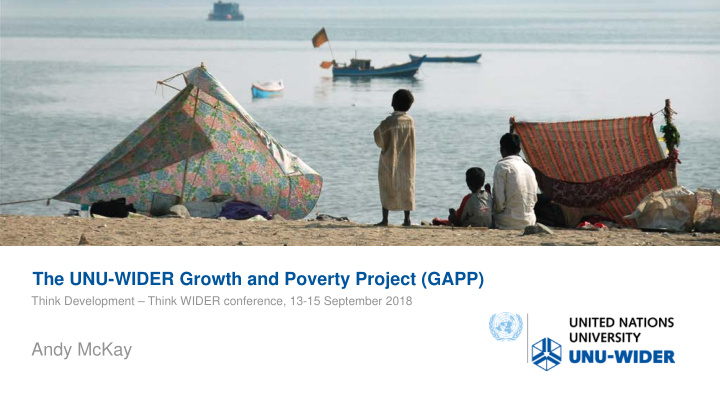



The UNU-WIDER Growth and Poverty Project (GAPP) Think Development – Think WIDER conference, 13-15 September 2018 Andy McKay
The UNU-WIDER Growth and Poverty Project • Background of pessimism about Africa in early 2000s • Turning into a more optimistic assessment – The Economist (3 December 2011): Africa rising – Optimistic cross-country studies: Pinskovskiy and Sala-i-Martin (2014) and Young (2012) – Alongside more pessimistic voices e.g. Afro-Barometer • Pressing questions: – What is really happening? – What is going on at country level? Policy implications? – The UNU-WIDER Growth and Poverty in Sub-Saharan Africa (GAPP) project •
Open access: https://www.wider.unu.edu /publication/growth-and- poverty-sub-saharan-africa
GAPP • Carried out 16 carefully designed country case studies from the 24 most populous countries in sub-Saharan Africa: – Ethiopia, Ghana, Malawi, Rwanda, Uganda, Burkina Faso, Mozambique, Nigeria, Tanzania, Zambia, Cameroon, Côte d’Ivoire, Kenya, Madagascar, South Africa and the DRC – Represent almost 75% of the African population and 9 of the largest 10 countries – Exact time period varies: generally the last two decades 16 high quality teams consisting of leading local and international experts, focused on – identifying and explaining trends in monetary and non-monetary poverty and their links to growth and inequality – Synthesis and interpretation by the editors • Key result: there is a lot to celebrate in African development (two cheers) – But not every where, and major challenges remain (not three cheers)
Background
The African Growth Turn-Around
Substantial Variability: The 16 GAPP Country Cases
Child Mortality – Nearly Halved Since 1995 Mortality rate, under-5 (per 1,000 live births) 195 175 155 135 115 95 75 55 35 15 1990 1991 1992 1993 1994 1995 1996 1997 1998 1999 2000 2001 2002 2003 2004 2005 2006 2007 2008 2009 2010 2011 2012 2013 Europe & Central Asia (developing only) East Asia & Pacific (developing only) Middle East & North Africa (developing only) Sub-Saharan Africa (developing only) Latin America & Caribbean (developing only)
Girls’ Secondary School Enrolment – Doubled Since 1995 School enrolment, secondary, female (% gross) 100 90 80 70 60 50 40 30 20 1995 1996 1997 1998 1999 2000 2001 2002 2003 2004 2005 2006 2007 2008 2009 2010 2011 2012 2013 Europe & Central Asia (developing only) East Asia & Pacific (developing only) Middle East & North Africa (developing only) Sub-Saharan Africa (developing only) Latin America & Caribbean (developing only)
The GAPP project
The GAPP Approach • Moving beyond analysis on cross country (WDI type) data • Bring together: – Available macroeconomic data – Comparable household budget surveys (at least two surveys from each country) – Demographic and Health Survey data, and – A host of other information (prices) • Critically examine validity and consistency of existing data (triangulation) • Develop coherent explanations at country level; work presented and discussed at WIDER meetings and conferences
Conference on Inclusive Growth in Africa
Four Categories of Countries • Relatively rapid economic growth and corresponding poverty reduction: Ethiopia, Ghana, Malawi, Rwanda, and Uganda • Relatively rapid economic growth and limited poverty reduction: Burkina Faso, Mozambique, Nigeria, Tanzania, and Zambia • Uninspiring or negative economic growth with corresponding stagnation or increasing poverty: Cameroon, Côte d’Ivoire, Kenya, Madagascar, and South Africa • Low-information countries: DRC
Concluding comments
Findings • Socio-economic progress in Sub-Saharan Africa has been markedly better than almost anyone expected 20 years ago, but progress has not been even • The development process without exception highly non- linear • The fragility of gains evident • The regional powerhouses of Kenya, Nigeria, and South Africa not among the better performers in terms of growth or poverty reduction
Findings (2) • The performance of agriculture has been really important explaining some of the better poverty outcomes • Structural transformation slow; limited industrialisation • Jobs and employment creation lagging • Aid has played important roles • Major challenge of future population growth • Available data sources remains a major challenge
www.wider.unu.edu Helsinki, Finland
Recommend
More recommend